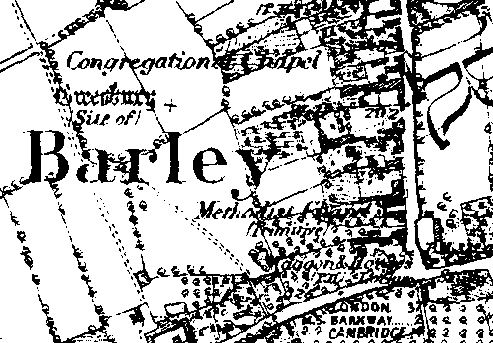|
Barley Chapel, 19th/20th Century September, 2008 |
|
||||||
Tracey Lilley (traceylilley54 @t hotmail.com) writes: I understand from my elderly grandmother that my family are buried in the 'Chapel' in Barley as opposed to the Church. Unfortunately my grandmother cannot recall where in Barley the Chapel was and I can find no reference to it on the Internet despite extensive searching. She recalls going as a girl she was born in 1921 so it was around in living memory.
 |
Extract from 6 inch 1882 OS Map showing Barley This extract shows the location of the Congregational Chapel and also a Methodist Chapel (Primative). |
I expect that the Chapel your grandmother was talking about was the one marked as Congregational Chapel on the above map, although there is also a Methodist Chapel marked.
The book Two Ears of Barley, by Jack Wilkerson, gives a lot of information about the nonconformist history of Barley, and it is clear that there were strong links between the Particular Baptists and the Independent (later Congregational) church. The book includes the following information about the Chapel, but unfortunately does not say whether it was still open when the book was written in 1969.
In 1841 a Baptist Chapel had been built in Barley, largely through the efforts of John Burgess, who farmed at the Horse Shoe Farm, and William Savell, the builder. They had previously registered a temporary building for worship in 1829. The accounts record two payments of £70 to a Mr. Wilkerson for bricks.
Clear Wilkerson worked the brick fields at Morris Green at that time so presumably bricks made locally were used in the building. These were no doubt the red bricks used in the side walls.
The Baptists used the pond in the Homestall meadow for baptism by total immersion-perhaps this is why their enthusiasm waned as the chapel was later closed for lack of support, and in 1889 a finance committee of Congregationalists under the chairmanship of James Wilkerson consisting of Thomas Parker, George Smith, A. E. Hagger, John and George Casbon, J. Clayden, Thos. Fielding, George Duke and Ellis Wilkerson was formed to take it over. The deeds were handed over free of debt by Mr. William Burgess in 1905.
It seems possible, from other records, that the chapel may initially have been used jointly by the Independent Church and the Baptists. In 1842 it was registered for the Independents, certified by William Savell, Geo. Albon and John Burgess, and separately registered by Henry Judd, farmer of Barley. (Nonconformity in Hertfordshire). In 1847 Upton listed Revd. W. Flutter as the Independent minister and reported that "The Dissenting Chapel is nearly new and unusually good." The Ecclesiastical Census of 1851 listed the minister as Thomas Flutter. (Religion in Hertfordshire 1847-1851). Another book, A History of the Hertfordshire Baptists, reports:
At Barley in North East Hertfordshire a group of Baptists seem to have broken away from the Independents in 1829. The cottage meeting had become large enough by 1841 to be able to build a chapel, but it did not flourish and closed in 1873. In 1889 their chapel was taken over by the Congregationalists.
However it should be noted that the Chapel is recorded as Congregational in the 1882 map, above, while the 1882 Kelly's Directory records "Here is a chapel, used chiefly by the Baptists".
There was also a separate burial ground. Two Ears of Barley records:
It is recorded from time to time that Non-Conformists were buried in "Widow Parker's garden" and in 1811 Thomas Brand, lord of the Manor, gave a piece of land formerly occupied by Mary Parker for additional burial ground. ... The burial ground must have got its name from an earlier Widow Parker as it is mentioned in 1692. Meetings were held in the house of Widow Elizabeth Parker in 1716, and a widow Mildred Parker is mentioned in 1659.
If you want to research your ancestors connections with the Chapel HALS holds records for the period 1841 to 1928, (under the heading United Reformed Church) described as church book, membership roll, financial records and miscellaneous papers.
In addition there is a book, which I have not seen, Great Chishill & Barley United Reformed Church, by R. W. Rooke, published in 1994, which may contain relevant information. You may be able to get information on the fate of the Chapel and graveyard in Barley by contacting the Great Chishill United Reformed Church which is still in use.
November, 2008
Tracey reports that she has visited Barley, and the chapel ceased to be used as such in 1994, and her ancestors are now buried in what is now a garden to a private house.
There is a web page for books on Religion in Hertfordshire


